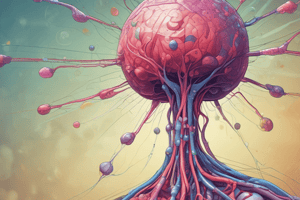Podcast
Questions and Answers
What is the process of programmed cell death characterized by cell shrinkage, chromatin condensation, and DNA fragmentation?
What is the process of programmed cell death characterized by cell shrinkage, chromatin condensation, and DNA fragmentation?
- Autophagy
- Necrosis
- Apoptosis (correct)
- Inflammation
What is the term for unprogrammed cell death resulting from injury or disease?
What is the term for unprogrammed cell death resulting from injury or disease?
- Autophagy
- Apoptosis
- Infection
- Necrosis (correct)
What is the cellular process that involves the formation of autophagosomes to recycle damaged or dysfunctional organelles and proteins?
What is the cellular process that involves the formation of autophagosomes to recycle damaged or dysfunctional organelles and proteins?
- Necrosis
- Apoptosis
- Autophagy (correct)
- Inflammation
What is the consequence of necrosis?
What is the consequence of necrosis?
What is the benefit of apoptosis?
What is the benefit of apoptosis?
What is the benefit of autophagy?
What is the benefit of autophagy?
What is the primary function of the mitochondria in a cell?
What is the primary function of the mitochondria in a cell?
Which organelle is responsible for removing waste products from the cell?
Which organelle is responsible for removing waste products from the cell?
What is the primary function of the cell membrane?
What is the primary function of the cell membrane?
What is the term for the basic building blocks of life that group together to form tissues?
What is the term for the basic building blocks of life that group together to form tissues?
What is the result of the process of cellular respiration in the mitochondria?
What is the result of the process of cellular respiration in the mitochondria?
What is the primary function of ATP in the cell?
What is the primary function of ATP in the cell?
What is the result of glycolysis in the process of aerobic respiration?
What is the result of glycolysis in the process of aerobic respiration?
What is the main difference between intracellular fluid (ICF) and extracellular fluid (ECF)?
What is the main difference between intracellular fluid (ICF) and extracellular fluid (ECF)?
What is the role of ATP in maintaining ion concentration gradients across the cell membrane?
What is the role of ATP in maintaining ion concentration gradients across the cell membrane?
What is the characteristic of the concentration gradient of sodium ions across the cell membrane?
What is the characteristic of the concentration gradient of sodium ions across the cell membrane?
Study Notes
Cell Adaptation and Injury
Apoptosis
- Programmed cell death, a natural process to eliminate damaged or unwanted cells
- Also known as "cell suicide"
- Characterized by:
- Cell shrinkage
- Chromatin condensation
- DNA fragmentation
- Formation of apoptotic bodies
- Induced by:
- DNA damage
- Oxidative stress
- Hormonal changes
- Infections
- Benefits:
- Eliminates damaged cells, preventing cancer
- Helps regulate tissue development and homeostasis
- Removes infected cells, preventing disease spread
Necrosis
- Unprogrammed cell death, resulting from injury or disease
- Characterized by:
- Cell swelling
- Plasma membrane rupture
- Release of cellular contents
- Inflammation
- Caused by:
- Ischemia (lack of blood flow)
- Toxins
- Infections
- Trauma
- Consequences:
- Inflammation and tissue damage
- Can lead to disease and organ dysfunction
Autophagy
- Cellular process for recycling damaged or dysfunctional organelles and proteins
- Involves:
- Formation of autophagosomes (membrane-bound structures)
- Fusion with lysosomes
- Degradation of contents
- Induced by:
- Starvation
- Oxidative stress
- Infections
- Cancer
- Benefits:
- Maintains cellular homeostasis
- Helps remove damaged or infected cells
- Promotes cell survival during stress
Note: These notes focus on the key concepts and differences between apoptosis, necrosis, and autophagy. For a more detailed understanding, additional resources may be necessary.
Cell Adaptation and Injury
Apoptosis
- Programmed cell death, a natural process to eliminate damaged or unwanted cells, also known as "cell suicide"
- Characterized by cell shrinkage, chromatin condensation, DNA fragmentation, and formation of apoptotic bodies
- Induced by DNA damage, oxidative stress, hormonal changes, and infections
- Benefits: eliminates damaged cells, preventing cancer; helps regulate tissue development and homeostasis; removes infected cells, preventing disease spread
Necrosis
- Unprogrammed cell death, resulting from injury or disease
- Characterized by cell swelling, plasma membrane rupture, release of cellular contents, and inflammation
- Caused by ischemia, toxins, infections, and trauma
- Consequences: inflammation and tissue damage; can lead to disease and organ dysfunction
Autophagy
- Cellular process for recycling damaged or dysfunctional organelles and proteins
- Involves formation of autophagosomes, fusion with lysosomes, and degradation of contents
- Induced by starvation, oxidative stress, infections, and cancer
- Benefits: maintains cellular homeostasis; helps remove damaged or infected cells; promotes cell survival during stress
Studying That Suits You
Use AI to generate personalized quizzes and flashcards to suit your learning preferences.
Description
Learn about apoptosis, a natural process of programmed cell death, its characteristics, benefits and inducing factors. Understand its role in eliminating damaged cells, preventing cancer and regulating tissue development.




